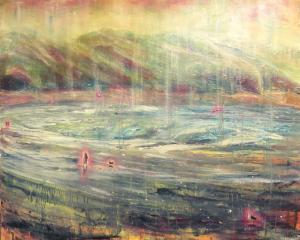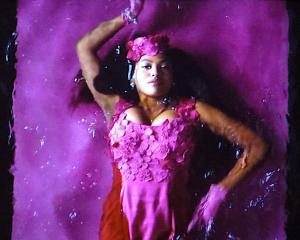In this week's Art Seen, Robyn Maree Pickens looks at exhibitions from Ammon Ngakuru, Zena Elliott, and the University of Otago.
 A Shelter for Amnesic Relatives, by Ammon Ngakuru.
‘‘A Shelter for Amnesic Relatives’’, Ammon Ngakuru (Blue Oyster Art Project Space)
A Shelter for Amnesic Relatives, by Ammon Ngakuru.
‘‘A Shelter for Amnesic Relatives’’, Ammon Ngakuru (Blue Oyster Art Project Space)

Ammon Ngakuru has combined video and installation to create an experience that is simultaneously bold and nuanced. He takes as his ostensible subject the survivalist subculture of North America, who in a seemingly counter-intuitive move, post videos of their secret bunkers on YouTube, which is where Ngakuru sourced the raw material that he would subsequently edit and install in the small back gallery space.
Echoing the difficult-to-access bunkers, Ngakuru has installed a provisional architectural space comprising walls of white shelving units that bracket off a large rectangular section of the main gallery space. The only way to step inside this space is by entering into the back gallery then stepping through a tall, narrow space that has been cut out of the back wall of the main gallery.
This intervention, this gap, manages to make material (even though it is absent space) the visual spatiality depicted in the video. By funnelling viewers into the back gallery through the construction of seemingly permeable yet inaccessible walls of shelving in the main gallery, the correspondence between the visual presentation of restricted space and the experience of restricted space produces a bodily experience of constriction. It is an adroit use of space and a timely cultural comment on those who would build walls.
 Seedlings In by Zena Elliott
‘‘Ripekanga/Intersections’’, Zena Elliott (Milford Galleries)
Seedlings In by Zena Elliott
‘‘Ripekanga/Intersections’’, Zena Elliott (Milford Galleries)

Ngati Awa artist Zena Elliott has selected an apt title in ''Ripekanga/Intersections'' for her latest body of work now on display at Milford Galleries. True to the language of ripekanga (intersections), Elliott's abstract paintings exhibit an energetic writhing of form, pattern and shape.
At the formal level Elliott draws both on the language of contemporary abstraction and Maori whakairo (carving) patterns. These two formal languages complement each other in ways that have been explored by a range of both Pakeha and Maori artists from Gordon Walters to Darryn George (Ngapuhi).
Elliot's exuberant patterns are contained in either a square or round form, although the paintings convey the feeling that the patterns have escaped the edges and continue to korero (converse) beyond the borders.
Within the square or round marine ply ground, the picture plane is further divided into smaller circles within squares within diamonds, and in different variations of this geometric schema.
Derived from whakairo patterns such as the pakati (dog-tooth notches) and haehae (parallel grooves), the patterns combine a hybrid of traditional Maori colours (red, black, white) with bright pink, orange, aqua and yellow.
Some paintings contain small patterned areas of layered-up spray paint, which offer a softness and depth to the hard, flat edges of the acrylic stripes, and small eye-like insets of paua.
 The Voyages of the Venetian Brothers, Nicolo and Antonio Zeno, to the Northern Seas in the XIVth Century.
‘‘Intrepid Journeys: Travelling with the Hakluyt Society’’ (University of Otago Special Collections)
The Voyages of the Venetian Brothers, Nicolo and Antonio Zeno, to the Northern Seas in the XIVth Century.
‘‘Intrepid Journeys: Travelling with the Hakluyt Society’’ (University of Otago Special Collections)

The Hakluyt Society was established in London in 1846 for the purpose of publishing primary records of sea voyages, intrepid travel and related geographical materials such as maps. Indeed maps are one of the key attractions in this wide-ranging exhibition that includes journeys made to Asia, the Middle East, Africa, North America, India, Australia, and circumnavigations of the globe between the 14th and 18th centuries.
Maps, such as ''The Voyages of the Venetian Brothers Nicol and Antonio Zeno to the Northern Seas in the XIVth Century'' (above), exemplify the historical mode of map-making as an unknown, hazardous and entirely hand-drawn undertaking replete with unavoidable miscalculations and appealing illustrations.
The exhibition includes a generous variety of such attractively illustrated maps both as foldouts from books and enlarged printed versions exhibited above the glass cabinets.
The fascination with such intrepid journeys, made in a time before satellite precision and digital dissemination, before so much of the world was ''known'' (able to be visualised), is necessarily tempered by the reality of empire that made and used maps for the purposes of conquest and colonisation.
It is this awareness of the impact such voyages of exploration had on the ''discovered'' peoples that flows alongside the thrill of adventure, the high seas and new lands.
-By Robyn Maree Pickens








![... we all become all of these things [installation view] (2025), by Megan Brady.](https://www.odt.co.nz/sites/default/files/styles/odt_landscape_small_related_stories/public/story/2025/03/1_we_all_become_all_of_thes.jpg?itok=SH-Q8KJZ)


![Poipoia te Kākano [installation view]. Allison Beck, Megan Brady, Kate Stevens West, Jess...](https://www.odt.co.nz/sites/default/files/styles/odt_landscape_small_related_stories/public/story/2025/02/1_poipoia_te_k_kano.jpg?itok=_BEDlada)

